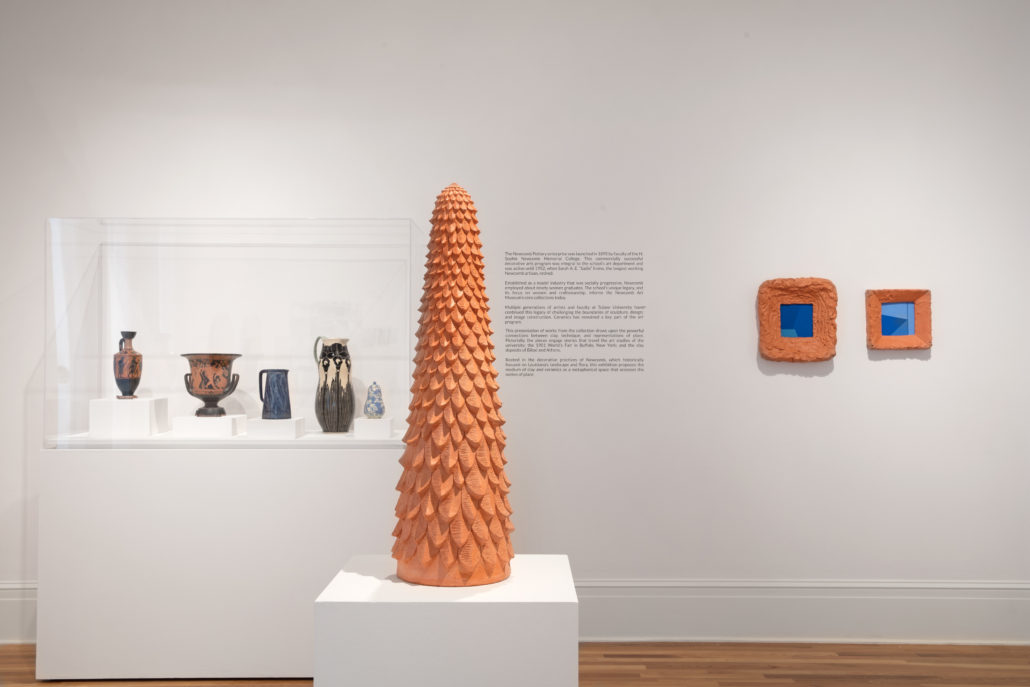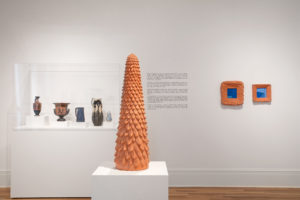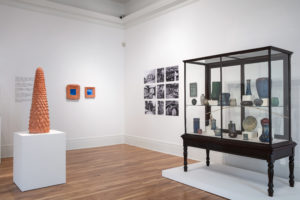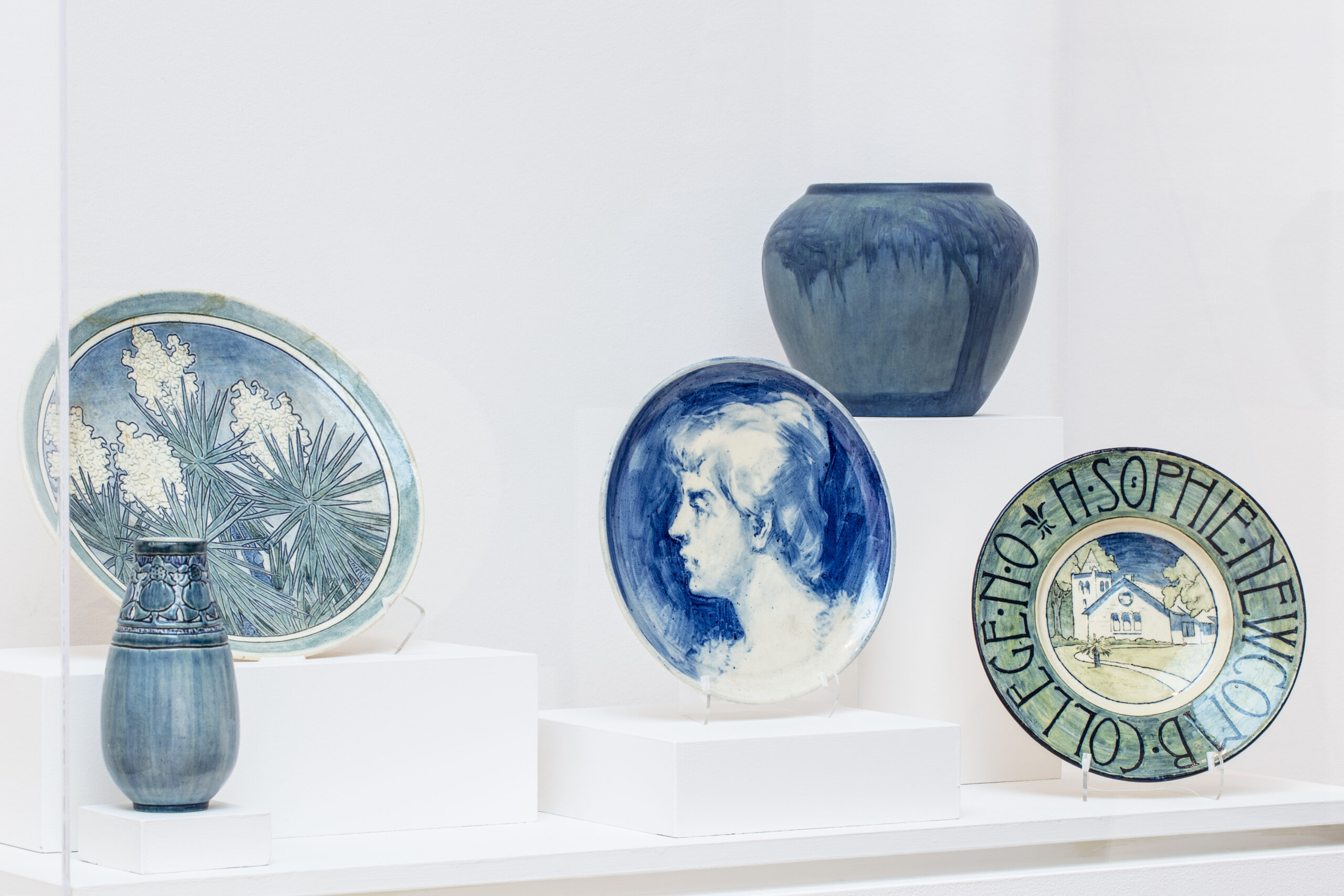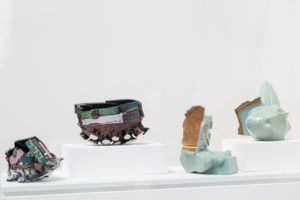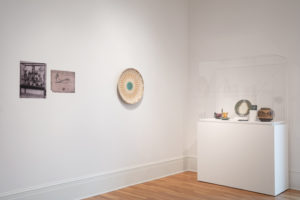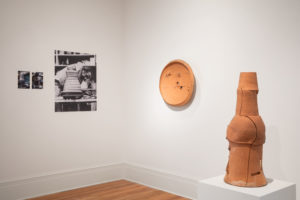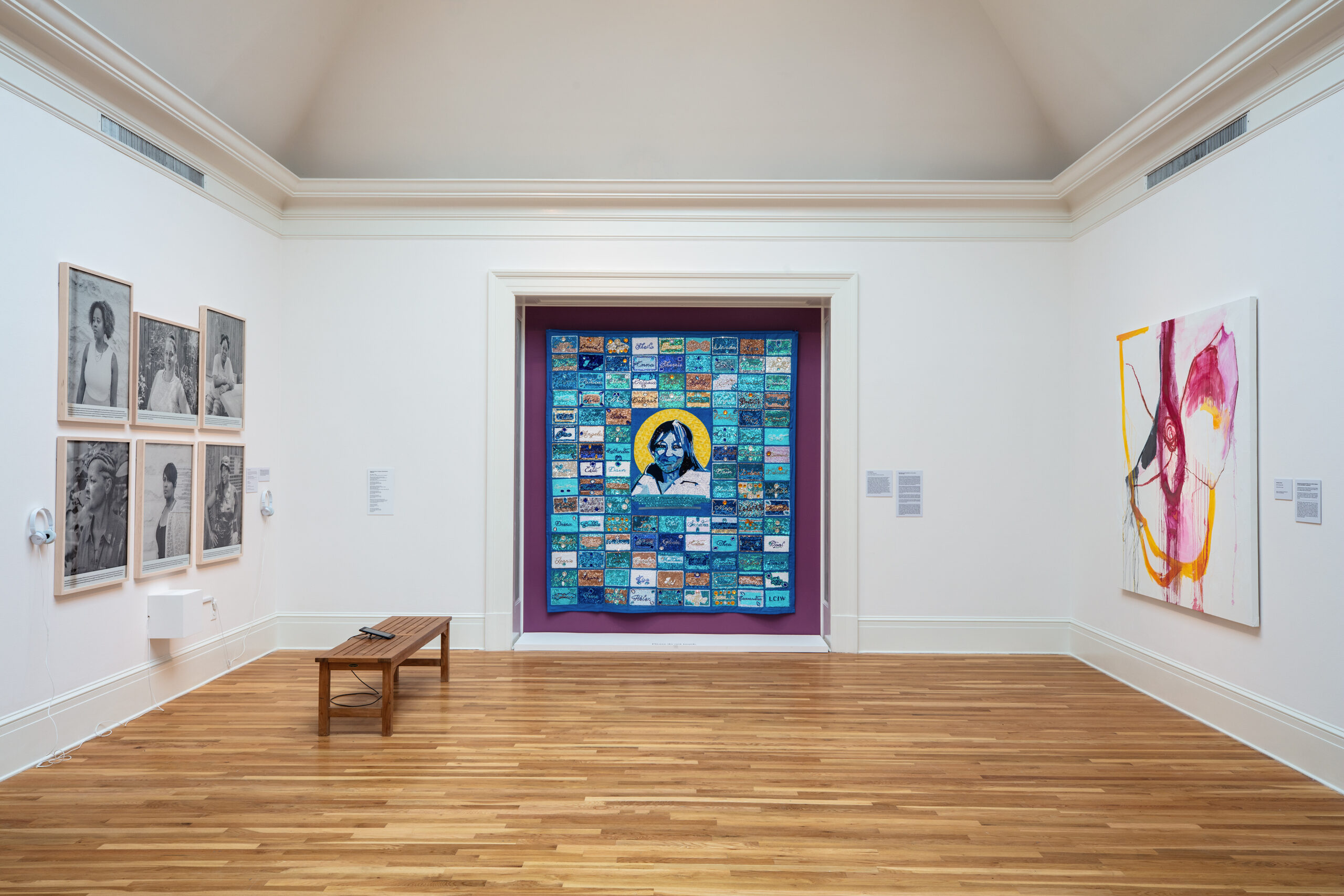Images
Katharine Kopman (b. 1869, New Orleans, LA; d. 1950) earned her Diploma in Art from Newcomb College in 1895 and was a member of the first pottery decoration class which opened in the Fall of that same year. She was a graduate art student from 1896 to 1898, and taught from 1896 as an Instructor in Drawing. In 1907, as the program began to be more defined, she became an Instructor in Drawing and Design. As a Supervisor of Cadets in 1909, she assumed charge of students enrolled in education, and taught in the High School. In 1913 she was made Supervisor of Practice, responsible for both special and Normal students. In 1918 Kopman became Supervisor of Art at Alexandria Grammar School in Alexandria, Louisiana and also taught at Louisiana College in Pineville. She exhibited pottery at the 1915 Panama-Pacific International Exposition in San Francisco and a series of Red Cross posters in November of 1917. (Excerpted from Newcomb Centennial, 1886-1986: An Exhibition of Art by the Art Faculty by Judith H. Bonner, exhibition catalog, published by Newcomb College, Tulane University, 1986, p. 34)
Marie de Hoa LeBlanc (b.1874, New Orleans, LA; d. 1954, New Orleans, LA) and her older sister, Emilie, were both Newcomb artisans whose work was part of the enterprise’s first public exhibition in 1897. LeBlanc graduated from the school’s Normal Art Program in 1898, and the following year was listed as a Graduate Art Student. In 1902 the Newcomb faculty awarded LeBlanc with a scholarship to attend Denman Waldo Ross summer course “Theory of Design: Lectures, with experimental practice, for designers, for teachers of Design, and for teachers of the History of Art” at Harvard University. Although her active dates as a decorator at Newcomb Pottery lasted only about a decade, she continued to be very involved with the arts of her hometown until her death in 1954. (Excerpted from “Marie de Hoa LeBlanc and Early Designs” by Adrienne Spinozzi, appearing in the Stickley Museum Notes from the Farm Newsletters, Summer 2016 and Fall 2016.)
Cynthia Pugh Littlejohn (b. 1890, near Napoleonville, LA; d. 1959, New Orleans, LA) attended Newcomb with her lifelong friend and neighbor Sadie Irvine. They both received a Diploma in Art the year of 1906, and their graduating class of nine has been noted by historian Jessie Poesch as yielding “one of the most talented and productive group of artisans in the Art School’s history.” Afterward, Littlejohn continued her studies in graduate school at Newcomb and received a 1908 travel scholarship. She also took courses at Columbia University in New York during the summer of 1910. In addition to pottery, Littlejohn created work in leather and leaded glass. Her pieces were included in the Panama-Pacific International Exposition in San Francisco in 1915.
Ada Wilt Lonnegan (b. 1879, New Orleans, LA; d. 1963, New Orleans, LA) was an early graduate of the Newcomb program. She enrolled in 1896 and received a Diploma in Art in 1900, before completing her graduate studies in 1901. Lonnegan specialized in calligraphy, drawing and pottery design. Her work was exhibited in 1904 in St. Louis at the Louisiana Purchase Exposition.
Ruth Maddox (active at Newcomb 1927 – 1930, d. 1966) received a Bachelor of Design from Newcomb, where she specialized in silversmithing, pottery, and wallpaper design. Her sister was Floy Maddox, another Newcomb artisan, whose papers are part of the Special Collections of Tulane University.
Joseph Fortune Meyer (b. 1848, Buthiers, Haute-Saône, France; d. 1931, New Orleans, LA) was a key figure of the Newcomb Pottery movement and helped build the pottery’s kilns. His stamped mark is visible on more pieces than any other single artisan in the group. He was also a mentor to ceramic artist George Ohr, “The Mad Potter of Biloxi”. Born in Alsace-Lorraine, France, Joseph Meyer grew up in Biloxi, Mississippi, learning the potter’s trade from his father. He eventually maintained his own pottery business in New Orleans before working at the Pottery Club of New Orleans from 1886 until 1890. In 1896 Meyer was called by Ellsworth Woodward to help set up the Newcomb pottery enterprise. From then until 1927 Meyer threw, glazed, and fired all the ware decorated by the women at the Pottery. He was an extremely skillful potter who could throw and trim virtually any shape or form requested by the decorators. Always active, he experimented with a number of clay bodies and glazes including copper-reds. (Excerpted from 100 Years of Ceramics at Newcomb College, 1894-1994. A Faculty Retrospective by Jeremy Jernegan, Jessie Poesch, and Tiffany Sherman, exhibition catalog, Newcomb Art Department, 1994, p. 11.)
Leona Fischer Nicholson (b. 1875, St. Francisville, LA; d. 1966) was an artist, educator, and ceramicist who specialized in tiles. She earned a Diploma in Art from Newcomb in 1901 before continuing the pottery program at the graduate level and earning a master’s degree. An active Newcomb artisan until 1929, she also attended Alfred University and was recognized by the Boston Society of Arts and Crafts. Nicholson also developed glazes and hand-built pieces as an independent ceramicist, at the encouragement of her mentor, Mary Given Sheerer. Later in life Nicholson founded and directed the ceramics program at the New Orleans Jewish Community Center on St. Charles Avenue, where she worked from 1941 for nearly two decades until her retirement.
Mary Given Sheerer (b. January 1865; d. 1954, Cincinnati, OH) was trained in the fine arts at the Cincinnati School of Art, which was strongly influenced by the English Arts and Crafts movement, and was also a pupil of the Art Students League in New York. Her primary experience and interest was in design and “industrial arts” and therefore, she was the perfect candidate to help establish the Newcomb Pottery. She arrived in 1894 to teach pottery design and supervise the decoration of the pottery at Newcomb College. Working closely with potters Jules Gabry and Joseph Meyer, Sheerer was primarily responsible for establishing a successful studio, making use of locally available equipment, clays, and glaze materials. As the professor of Pottery and China Decoration, her aesthetic strongly influenced the shape and character of the Newcomb ceramics program for almost forty years. (Excerpted from 100 Years of Ceramics at Newcomb College, 1894-1994. A Faculty Retrospective by Jeremy Jernegan, Jessie Poesch, and Tiffany Sherman, exhibition catalog, Newcomb Art Department, 1994, p. 8.)
Erin “Effie” Shepard (b. 1883, New Orleans, LA; d.1917) attended Newcomb as a Normal Art student from 1900-1903 when she received a Diploma in Art. She was enrolled as a Graduate Art student between 1903 and 1909. She joined the ranks of Arts Craftsmen from 1910-1913. An award-winning watercolorist, Miss Shephard also distinguished herself in the fields of pottery decoration and metalwork. (Excerpted from Newcomb Pottery by Jessie Poesch, Schiffer Publishing Ltd.,1984, p. 104)
Anna Frances “Fanny” Simpson (b. 1880, New Orleans, LA; d. 1930) received a Diploma in Art from Newcomb College in 1906 and earned her Master’s degree in 1908. Afterward, she was employed by the Pottery over two decades, until 1929, shortly before her death. In 1930, a solo exhibition of her work was featured posthumously at the Museum of Fine Arts Houston.
Kenneth Eugene Smith (b. 1907, d. circa 1980) joined Newcomb in 1929 to supervise the technical direction of the pottery and remained on faculty until 1946. He was a ceramic chemist and pottery instructor who, after Jonathan Hunt’s departure in 1933, also became a potter for Newcomb Pottery and Newcomb Guild – the latter of which he helped establish in 1942 with a proposal to Tulane’s Board of Administrators. From 1943-1945 he also taught in the Tulane College of Engineering. Hunt later worked for the US State Department in Honduras, where he helped establish and became faculty at the La Escuela Nacional de Nella Artes in Tegucigalpa. In 1946, Smith moved to Indianapolis where he worked for the American Art Clay Company until his retirement in 1974. An editor for Ceramics Monthly more than twenty years, he was also a member of the American Ceramic Society, the National Institute of Ceramic Engineers, and served as a past president of the Southeastern Art Association. Smith earned a BS in ceramic engineering at Alfred University in New York in 1929 before continuing on to graduate school at Ohio State University, where he earned an MFA in 1939 based on three years of Summer study.
Jeffrey Thurston (b. 1984, Sacramento, CA; lives in New Orleans, LA) is a 2016 graduate of Tulane’s MFA program, and presently an adjunct professor teaching ceramics at Tulane. He holds a BFA from California State University, Chico, and also studied at Diablo Valley College in Walnut Creek, CA. Thurston grew up in the San Francisco Bay area, and his recent work is informed by an early memory of ships moored at the bank of the Carquinez Strait, near the Benicia-Martinez bridge. The objects he creates bear a physical reference to the instability of traveling by sea, while also more broadly representing the notion of a watertight ceramic vessel, and the archaeological significance of pottery fragments that can surface over time. “A lot of my practice deals with a sense of uneasiness,” says the artist. “I don’t think I’ve ever felt totally at ease at any one place.” While living in California he recalls, “I was just inundated with [Peter] Voulkos’s work, so 3D-wise, that’s where I get a lot of influence … there’s a roughness and a rawness that he uses. I’ve been trying to capture that in my own work.”
Lauren “Lola” Victor (b. 1993, San Diego, CA; lives in Europe) is a 2016 graduate of Tulane’s BA program. She studied Studio Art and English Literature, with a special interest in Gender and Sexuality Studies. She complemented her education in New Orleans with further training at the Studio Art Centers International in Florence, Italy, where she also worked with the Museum of Anthropology to help create a digital archive of 19th-century photographs from Italian anthropological expeditions. Primarily using ceramics in her art, Victor creates socially conscious work that explores notions of “the body and identity, using history as a lens”. In 2017 Victor lived in Italy and Austria, working for the European Cultural Centre for the Venice Biennale, and the Urhof20 international performance art festival in Grünbach Am Schneeberge, near Vienna. She is presently based abroad and most recently traveled to Israel. This fall, she anticipates the start of her graduate studies at the Royal College of Art in London, where she will focus on ceramics and glass.
Peter Voulkos (b. 1924, Bozeman, MT; d. 2002, Bowling Green, OH) is among the most influential figures of American ceramics. Voulkos created sculpture that elevated the medium of ceramics to “new levels of abstraction and personal expression,” in the words fo The New York Times arts writer Roberta Smith. Following a 1953 summer teaching post at Black Mountain College, where he befriended Franz Kline, Voulkos founded two important ceramics departments on the West Coast: first in 1954 at the Los Angeles County Art Institute, now known as the Otis College of Art and Design; and next in 1959 at the University of California at Berkeley, where he remained on faculty until 1985. While on sabbatical, Voulkos was invited to present an artist lecture and demo in New Orleans at Tulane University. His visit occurred in the Spring 1978 semester, from February 28 through March 3, and it accompanied a three-week solo exhibition in the space now known as the Carroll Gallery. His visit was sponsored by the then recently established Alumni Visiting Artists Program, which was founded by two 1965 Newcomb graduates, Patty Whitty Johnson and Mary Sue Nelson Roniger. Voulkos earned a BS in Painting from Montana State University and an MFA in 1953 from the California College of the Arts and Crafts in Oakland. In 2016 a solo exhibition of his work, “Voulkos: The Breakthrough Years,” opened at the Museum of Art and Design in New York and traveled in 2017 to the Smithsonian’s Renwick Gallery in Washington DC.
Sabina Elliot Wells (b. 1876, Charleston, SC; d. 1943, Hoopers Creek, NC) created some of the Newcomb Pottery’s most impressive pieces, though she was not with the enterprise for long. She enrolled for one session, 1902-1903, as a Special Art student. The following sessions, 1903-1904, she was listed in the Pottery Design class. Her boldly incised motifs show both close observation of nature and a strong sense of design. Three examples of Well’s work were shown in at the Louisiana Purchase Exposition held at St. Louis in 1904; a vase with incised water lily design a plate with a shrimp design, and a vase with incised design of lioness. Though she had left Newcomb some years before, examples of her work, no doubt those retained in the College collection, were shown in the Newcomb exhibits at the Panama-Pacific International Exposition in San Francisco in 1915. The papers of artist, designer, and book illustrator Sabine Elliott Wells are held by the South Carolina Historical Society in Charleston. (Excerpted from Newcomb Pottery by Jessie Poesch, Schiffer Publishing Ltd.,1984, p. 106)
Ellsworth Woodward (b. 1861, Seekonk, MA; d. 1939, New Orleans, LA) was a teacher, artist, promoter and pillar of the New Orleans art scene between 1890 and 1940. He painted in an impressionist style all his life but, though his work was popular, his primary influence was as teacher and institution builder. He is particularly known as one of the founders of Newcomb Pottery at Sophie Newcomb College (now part of Tulane University) in New Orleans. A proponent of the Arts and Crafts movement, popular in the late nineteenth and early twentieth centuries, Woodward advocated local crafts as an alternative to standardized, machine-made wares … Educated at the Rhode Island School of Design, Ellsworth also studied abroad briefly in Munich, under Carl Marr and Richard Fehr … During his long career, Woodward promoted his aesthetic idealism through substantial organizational service. In 1900, he established the New Orleans Art Association. Twelve years later, he chaired the art committee at the newly established Isaac Delgado Museum of Art (now the New Orleans Museum of Art) and became its president in 1924. In 1920, he cofounded the Southern States Art League, over which he presided from 1926 to 1933. But the pottery he established on the Newcomb campus in 1895 remains both his longest and best-known attempt to institutionalize his vision of art and society. (Excerpted from “Ellsworth Woodward” by Richard Megraw, appearing in knowlouisiana.org Encyclopedia of Louisiana, edited by David Johnson. Louisiana Endowment for the Humanities, 2010–. Article published January 21, 2011. http://www.knowlouisiana.org/entry/ellsworth-woodward.)

